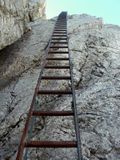Tag:highway=via_ferrata
| Description |
|---|
| A mountain route equipped with fixed cables, stemples, ladders, and bridges where climber is attached to supporting equipment limiting fall. |
| Group: highways |
| Used on these elements |
| Implies |
| Useful combination |
| Status: in use |
| Tools for this tag |
|
Use highway=via_ferrata to represent a ![]() via ferrata ('steel path'; in German speaking countries: Klettersteig) for traversing a mountainside. Usually very exposed and gear required.
via ferrata ('steel path'; in German speaking countries: Klettersteig) for traversing a mountainside. Usually very exposed and gear required.
Although the proposal was heavily disputed, this tag is already in use for some years and several renderers such as OpenAndroMaps and OsmAnd support it.
How to map
Draw a way and tag it with highway=via_ferrata. In rare cases when the ferrata is extremely steep, it can be drawn as a single node. Add via_ferrata_scale=*. However, via ferratas should not be confused with climbing=* routes. Via ferratas are unsuitable for bicycles, horses and vehicles.
If the via ferrata is walkable without special equipment by experienced hikers, add a corresponding difficulty level as sac_scale=*. In this case highway=path with assisted_trail=* may also be used as main tag, depending on which use is prevalent (a rule of thumb: do most people passing there use via ferrata gear?).
Details along the way can be tagged as such:
| Key | Value | Element | Comment | Example |
|---|---|---|---|---|
| bridge | yes | An unspecified bridge type along the via ferrata route | ||
| bridge:structure | simple-suspension | "Tibetan" or other very simple hanging/swinging bridges including 2 or more rope bridges see bridge:structure=simple-suspension for more details | ||
| cable_number | 2 or more | For cable bridges the total number of cables, in addition to bridge=yes and bridge:structure=simple-suspension | (here a 3 cable bridge) | |
| aerialway | zip_line | A zip line along the via ferrata route see aerialway=zip line | ||
| oneway | yes | If the via ferrata is not allowed both ways | ||
| ladder | yes/length in m | Steel ladder, see ladder=* | ||
| rungs | yes/amount | Rungs, stemples, pins | ||
| tunnel | yes | A tunnel along the via ferrata route | ||
| natural | cave | Via ferrata route through a cave (see proposal natural=cave) | ||
| overhang | yes/no/ length in m | Overhanging sections of significant length |
Seasonal Access
Some ferratas are seasonally closed due to a variety of restrictions (wildlife, snow/ice, etc.). These restrictions are typically posted on physical signs in the vicinity of the respective ferratas.
As used for other ways and relations, access:conditional=* in conjunction with the opening_hours=* syntax can be used to map such restrictions. Placing such a restriction should explicitly mention foot, especially where foot is already in the tags, e.g. foot=yes; foot:conditional=no @ (Nov 1-Apr 30) will help prevent unsuspected surprises.
Via ferrata as relation
Ways that together form a distinguishable via_ferrata unit (usually named) can be grouped into a relation route=via_ferrata.
History
Before highway=via_ferrata was proposed, various methods were in use – some of which remain in widespread use until now. sport=via_ferrata was the earliest known proposal (see Proposed features/via ferrata version 1). While sport=via_ferrata is rarely used today, it might have some utility if it would be defined to have a meaning like other contemporary sport tags. After the sport=ferrata proposal was inactive, highway=path in combination with various tags that would declare the path to be a ferrata became the method of choice and as of May 2019 almost half ferratas were still mapped as highway=path+via_ferrata_scale=* (although the numbers should be used with caution as a significant share of objects mapped with either method may be actually hiking paths with additional security features). Historically, there were tags such as ferrata=yes which would make a path into a ferrata. In March 2019 a proposal for this method was launched (see Via Ferrata Simplified) which was abandoned after not receiving support during the RFC.
Proposed features/via ferrata introduced highway=via_ferrata and the issue of using highway=path vs highway=via_ferrata was heavily disputed. Currently, it seems ways which can be used as either hiking path (as long as the hiking difficulty fits into the range covered by sac_scale) or as via ferratas can be mapped with via_ferrata_scale=* + sac_scale=* with either highway=via_ferrata or highway=path. On the other hand mapping of ferratas not suitable for hiking as highway=path for the purpose of having them rendered in some of the renderers not supporting highway=via_ferrata could be considered troll tag and mapping for the renderer.
Renderer support
Offline maps
- OpenAndroMaps and render theme Elevate, e.g. in Locus
- OsmAnd
- Trekarta (formerly MapTrek)








